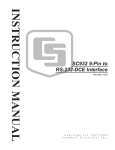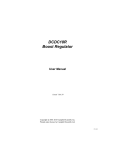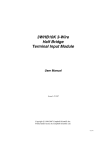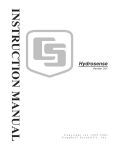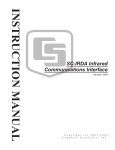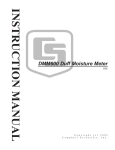Download Campbell SC932C 9-Pin Instruction manual
Transcript
INSTRUCTION MANUAL SC932C 9-Pin to RS-232-DCE Interface Revision: 6/97 C o p y r i g h t ( c ) 1 9 9 7 C a m p b e l l S c i e n t i f i c , I n c . Warranty and Assistance The SC932C 9-PIN TO RS232-DCE INTERFACE is warranted by CAMPBELL SCIENTIFIC, INC. to be free from defects in materials and workmanship under normal use and service for twelve (12) months from date of shipment unless specified otherwise. Batteries have no warranty. CAMPBELL SCIENTIFIC, INC.'s obligation under this warranty is limited to repairing or replacing (at CAMPBELL SCIENTIFIC, INC.'s option) defective products. The customer shall assume all costs of removing, reinstalling, and shipping defective products to CAMPBELL SCIENTIFIC, INC. CAMPBELL SCIENTIFIC, INC. will return such products by surface carrier prepaid. This warranty shall not apply to any CAMPBELL SCIENTIFIC, INC. products which have been subjected to modification, misuse, neglect, accidents of nature, or shipping damage. This warranty is in lieu of all other warranties, expressed or implied, including warranties of merchantability or fitness for a particular purpose. CAMPBELL SCIENTIFIC, INC. is not liable for special, indirect, incidental, or consequential damages. Products may not be returned without prior authorization. The following contact information is for US and International customers residing in countries served by Campbell Scientific, Inc. directly. Affiliate companies handle repairs for customers within their territories. Please visit www.campbellsci.com to determine which Campbell Scientific company serves your country. To obtain a Returned Materials Authorization (RMA), contact CAMPBELL SCIENTIFIC, INC., phone (435) 753-2342. After an applications engineer determines the nature of the problem, an RMA number will be issued. Please write this number clearly on the outside of the shipping container. CAMPBELL SCIENTIFIC's shipping address is: CAMPBELL SCIENTIFIC, INC. RMA#_____ 815 West 1800 North Logan, Utah 84321-1784 CAMPBELL SCIENTIFIC, INC. does not accept collect calls. SC932C 9-Pin to RS232-DCE Interface Table of Contents PDF viewers note: These page numbers refer to the printed version of this document. Use the Adobe Acrobat® bookmarks tab for links to specific sections. 1. Installation...................................................................1 2. Use with Intelligent Telephone Modems ...................1 3. Other Applications......................................................1 Appendices A. SC932C to RS232 Device Connection Details...... A-1 A.1 Cable for Connection to a 25-Pin DCE Interface.................................A-1 A.2 Cable for Connection to a 9-Pin DCE Interface...................................A-1 B. Technical Details of Special Modes of Operation B-1 B.1 B.2 B.3 B.4 Power Modes........................................................................................B-1 Handshaking Lines ...............................................................................B-1 ‘Printer Only’ Output ...........................................................................B-1 Maximum Recall Interval.....................................................................B-2 C. Specifications......................................................... C-1 List of Figures 1. SC932C Connected to RAD Short-Haul Modem........................................1 A-1. Minimum Connections for SC932C to 25-pin DCE Interface ............A-1 A-2. Minimum Connections for SC932C to 9-pin DCE Interface ..............A-1 B-1. Connections for Using SC932C in ‘Printer’ Mode .............................B-2 List of Tables C-1. 25-Pin Male Connector Pin-out ..........................................................C-2 C-2. 9-Pin Male Connector Pin-out ............................................................C-2 i This is a blank page. SC932C 9-PIN TO RS232-DCE INTERFACE The SC932C is used to interface a Campbell Scientific datalogger to modem devices that are configured with an RS232 DCE (Data Communications Equipment) serial port. The most common application is to allow the connection of a RAD short haul modem or third party telephone modem to a datalogger. The SC932C has the following features: • Generates true RS232 signal levels to the DCE device, resulting in good noise immunity. • Powered from the 5V supply of the datalogger, which is also available to provide power to the DCE, if required for line-powered modems. • Generates the required ring signal to wake up the datalogger, either when characters are received or when there is a ring signal from the DCE. • Allows simultaneous connection of synchronous devices (e.g., Storage Modules) to the datalogger. • Provides a mechanism for the datalogger to control the line state of intelligent modems via DTR handshaking control. • Convenient ‘jumperless’ design. 1. INSTALLATION Use the SC12 ribbon cable (provided) to connect the datalogger’s 9-pin CS I/O port to the 9-pin connector on the SC932C. The SC932C can usually be connected to the RS232 device by plugging the SC932C directly into the serial connector on the RS232 device. No further configuration is normally required. A typical application with a RAD modem would comprise: SC932C FIGURE 1. SC932C Connected to RAD Short-Haul Modem If the RS232 device does not have a suitable 25-pin ‘D’ socket, you may need an adaptor cable (see Appendix A). prevent the modem staying on-line unnecessarily, which can lead to excessive telephone charges and also delay reconnection to the datalogger. Most phone modems can be configured to respond to the DTR line, although this is not always the default setting. Although this feature is sometimes controlled by a hardware configuration switch, more often it is a software setting, e.g. AT&D2&W is the command for a Hayes-compatible modem to force the modem to follow the DTR status. 3. OTHER APPLICATIONS The SC932C can be used in more specialized applications. Appendix B gives installation details where even lower power consumption may be possible, and also for applications where higher power outputs for the RS232 device are required. 2. USE WITH INTELLIGENT TELEPHONE MODEMS If an ‘intelligent’ telephone modem is being used, configure it to allow the SC932C to control its line status via the DTR line. This can 1 This is a blank page. APPENDIX A. SC932C TO RS232 DEVICE CONNECTION DETAILS This Appendix gives details of the cables required for connection of an SC932C to DCE type RS232 devices, if the SC932C cannot be directly plugged into the 25-pin DCE, RS232 socket. A.1 CABLE FOR CONNECTION TO A 25-PIN DCE INTERFACE A standard pin-to-pin cable is suitable. However, if a custom cable is to be made it must make the following minimal connections: SC932C 25-Pin D Pin No. 25-Pin D Pin No. 2 2 3 3 7 7 20 20 4* 4* 1 DCE Device Cable Shield FIGURE A-1. Minimum Connections for SC932C to 25-pin DCE Interface NOTE: The link between pins 4 and 4 marked with the * may not be required — see the section on low power operation in Appendix B. A.2 CABLE FOR CONNECTION TO A 9-PIN DCE INTERFACE Some newer modem-type devices are fitted with 9-pin D connectors designed to plug directly into 9-pin serial ports as found on most ‘AT’ style PCs. Commercial adaptor cables are available. If you use a custom made cable, it should have the following connections: SC932C 25-Pin D Pin No. 9-Pin D Pin No. 2 3 3 2 7 5 20 4 4* 7* 1 DCE Device Cable Shield FIGURE A-2. Minimum Connections for SC932C to 9-pin DCE Interface NOTE: The link between pins 4 and 7 marked with the * may not be required — see the section on low power operation in Appendix B. A-1 This is a blank page. APPENDIX B. TECHNICAL DETAILS OF SPECIAL MODES OF OPERATION The SC932C is designed as a simple plug-in device with no internal jumpers. This Appendix describes alternative modes of operation and also relates these to Campbell Scientific’s original SC932 interface, for those users who are already familiar with that interface. B.1 POWER MODES B.1.1 NORMAL MODE In the normal mode of operation for the SC932C, a continuous supply of 4.3V is available from the RTS line; this can be used as a source of power by some interfaces, e.g. the RAD modem. The RTS and DTR lines both switch to >7V when the SC932C becomes active. This mode will work for the majority of applications. This mode is similar to the medium power setting of the SC932. B.1.2 HIGH POWER MODE A ‘high power’ setting can be forced, where RTS and DTR are held permanently at >7V, by connecting pin 11 of the 25-pin D connector to a voltage >3.5V DC. To do this, add a link between pins 11 and 4 (RTS) on the SC932C’s 25-pin D connector. In this mode the SC932C consumes approximately 10-15mA continuously. This mode is normally only necessary for devices which require fully active input lines to provide a source of power to allow them to receive data and transmit it to the SC932C. NOTE: In this mode the SC932C will not block the transmission of synchronous data (e.g. Storage Module data) to the RS232 device. This could cause a problem if, for example, the RS232 device is reconfigured by the stream of binary data. Synchronous data is not normally transmitted through the SC932C when in its normal mode of operation. B.1.3 LOW POWER MODE The lowest power consumption can be achieved with RS232 devices which do not need to source power from the SC932C. This is done by not connecting pin 11 or the RTS line to the RS232 device. This is because a small current will flow from the active RTS line into a standard RS232 RTS input on the device (normally <1.5mA), even when the SC932C is inactive. Leaving RTS disconnected will only work if the RS232 device does not require an active RTS line during communication. Many high speed modems do have this requirement, by default, but RTS/CTS handshaking can usually be turned off by software reconfiguration (please refer to the modem manual). B.2 HANDSHAKING LINES In its normal power mode, and when inactive (i.e., the datalogger ME line is low) the SC932C only holds the RTS line high to provide a source of power to line-powered modems, such as the RAD modem. The DTR line is controlled by the ME line of the datalogger. When ME is high the DTR line is powered high (>7V), but when the ME line returns to a low state, the DTR line enters a high impedance state; as far as the RS232 device is concerned, this has the same effect as the DTR line going low. This transition can be used to force the device to go off-line, if the device supports this. This feature is useful for some telephone modems as it allows the datalogger to force the modem off-line. The older SC932 only supports this type of handshaking when operated in its low power mode. NOTE: The SC932C can be modified to support a form of RTS handshaking for the support of some specialized half-duplex interfaces. Please contact Campbell Scientific for further details. B.3 ‘PRINTER ONLY’ OUTPUT The SC932C can be used as a printer (PE/SDE enabled) device. However, unlike the SC932 where this mode can be set using internal jumpers, the SC932C requires a special connection in place of the normal direct SC12 cable. The connection to the SC932C should be made up as follows: B-1 APPENDIX B. TECHNICAL DETAILS OF SPECIAL MODES OF OPERATION Datalogger Pin No. SC932C 9-Pin D Pin No. 1 1 2 2 4 No connection to SC932C 5 No connection to SC932C 6 5 9 9 FIGURE B-1. Connections for Using SC932C in ‘Printer’ Mode (Other wires can be left connected or disconnected.) With this connection the SC932C can be connected in parallel to another Campbell Scientific modem-type device. However, as with the SC932, any data output to synchronous devices (e.g., a Storage Module) will also be transmitted out through the RS232 connection. B.4 MAXIMUM RECALL INTERVAL From the time that the datalogger leaves communications mode (ME goes low), there is a delay of approximately one second before serial or ring line activity from the RS232 device will re-awaken the datalogger. This prevents spurious messages from the RS232 device (such as ‘loss of carrier’ messages from a modem) waking up the datalogger. The only consequence of this delay is that specialized software which polls dataloggers at frequent intervals will not be able to wake the same datalogger again during the delay period. Campbell Scientific are aware of some modems which will re-trigger the ring line, despite this delay. The only consequence of this is that the datalogger will remain in communications mode for an extra 30 seconds after the end of the call; this will waste a small amount of power and delay any output to a Storage Module. B-2 APPENDIX C. SPECIFICATIONS Data rates: up to 38,400 baud (limited by datalogger) • RTS full power 7 - 9V with 3kΩ load (ME high) Size: 63 x 55 x 17mm (L x W x D), excluding mating D connectors • DTR 7.5 - 9.5V with 3kΩ load (8.8V typical with RAD); short circuit current 30mA typical • Tx greater than ±5V with 3kΩ load Operating environment: -25°C to +50°C, 095% RH (non-condensing) Connector pin assignments: see Tables C-1 and C-2 Power requirements: sources power from datalogger 5V supply via 9-pin interface. TYPICAL CURRENT CONSUMPTION RS232 INPUT THRESHOLDS RX AND RI • Input low 0.8V minimum • Input high 2.4V maximum • Input resistance 5KΩ • <100 µA with no RS232 load and pin 11 not connected • 2.2 mA with RAD and no communication • • Input low 1.3V maximum (normal power mode) 9.3 mA with RAD, datalogger in communications mode, but low communications activity • Input high 3.5V maximum (to enable high power mode) • Input resistance greater than 10kΩ • Maximum input voltage 20V • 10.2 mA with RAD, high communications activity Current consumption when driving other RS232 modems will vary with the number of lines connected and the input impedance of the inputs. With 3 inputs connected (DTR, RTS and Tx from the SC932C), of the minimum 3kΩ input impedance, and high communications activity the consumption may be up to 16mA. RS232 OUTPUT LEVELS • RTS 4.2 - 4.5V with 3kΩ load – quiescent state (ME low) PIN 11, POWER CONTROL INPUT THRESHOLDS TIME-OUTS • Minimum RING IN pulse width to generate a ring signal to the datalogger is 20µs • Minimum delay between ME going low and RING IN enable is 0.5s (1s typical) EMC SPECIFICATION • Emissions BSEN 55022-1: 1995 • Immunity BSEN 50082-1: 1992 C-1 APPENDIX C. SPECIFICATIONS CONNECTION DETAILS TABLE C-1. 25-Pin Male Connector Pin-out Pin No. I/O Name Description 1 2 out GND TXD 3 in RXD 4 7 11 out in RTS GND PWR 20 out DTR Chassis Ground SC932C transmits data on this line SC932C receives data on this line Held active by SC932C Signal Ground If held >3.5V will force SC932C into high power mode Held high if ME is high (see Appendix B) TABLE C-2. 9-Pin Male Connector Pin-out Pin No. I/O Name Description 1 2 3 4 in out out +5V GND RING RXD 5 6 in in ME SDE 9 in TXD C-2 Regulated 5V supply Ground Ring signal to datalogger SC932C transmits on this line Modem Enable Synchronous Device Enable/Print Enable SC932C receives on this line This is a blank page. Campbell Scientific Companies Campbell Scientific, Inc. (CSI) 815 West 1800 North Logan, Utah 84321 UNITED STATES www.campbellsci.com [email protected] Campbell Scientific Africa Pty. Ltd. (CSAf) PO Box 2450 Somerset West 7129 SOUTH AFRICA www.csafrica.co.za [email protected] Campbell Scientific Australia Pty. Ltd. (CSA) PO Box 444 Thuringowa Central QLD 4812 AUSTRALIA www.campbellsci.com.au [email protected] Campbell Scientific do Brazil Ltda. (CSB) Rua Luisa Crapsi Orsi, 15 Butantã CEP: 005543-000 São Paulo SP BRAZIL www.campbellsci.com.br [email protected] Campbell Scientific Canada Corp. (CSC) 11564 - 149th Street NW Edmonton, Alberta T5M 1W7 CANADA www.campbellsci.ca [email protected] Campbell Scientific Ltd. (CSL) Campbell Park 80 Hathern Road Shepshed, Loughborough LE12 9GX UNITED KINGDOM www.campbellsci.co.uk [email protected] Campbell Scientific Ltd. (France) Miniparc du Verger - Bat. H 1, rue de Terre Neuve - Les Ulis 91967 COURTABOEUF CEDEX FRANCE www.campbellsci.fr [email protected] Campbell Scientific Spain, S. L. Psg. Font 14, local 8 08013 Barcelona SPAIN www.campbellsci.es [email protected] Please visit www.campbellsci.com to obtain contact information for your local US or International representative.















